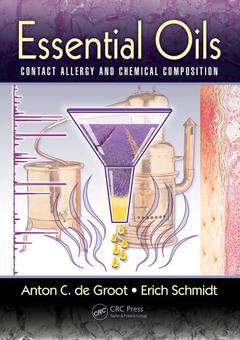Description
Essential Oils
Contact Allergy and Chemical Composition
Authors: de Groot Anton C., Schmidt Erich
Language: English
Subjects for Essential Oils:
Keywords
Essential Oil; Allergic Contact Dermatitis; Allergens; ISO Value; Linalyl Acetate; Allergies; Positive Patch Test Reactions; Chemical composition; Positive Patch Tests; Chemistry; Contact Allergy; Concentration; CAS Registry Number; Tea Tree Oil; Dermatology; Methyl Eugenol; Jasmine absolute; Occupational Contact Dermatitis; Lavender oil; Geranyl Acetate; Sandalwood oil; Contact Dermatitis; Rose oil; Cedarwood Oil; Methyl Chavicol; Turpentine oil; Occupational Allergic Contact Dermatitis; Ylang-ylang oil; Ylang Ylang Oil; Essential oils; Spearmint Oil; Neroli Oil; Peppermint Oil; Terpinyl Acetate; Clove Leaf Oil; Lavandin Oil; Cinnamon Oils; Bergamot Oil
Approximative price 220.72 €
In Print (Delivery period: 15 days).
Add to cart· 21x29.7 cm · Hardback
Description
/li>Contents
/li>Biography
/li>
Essential Oils: Contact Allergy and Chemical Composition provides a full review of contact allergy to essential oils along with detailed analyses of the chemical composition of essential oils known to cause contact allergy. In addition to literature data, this book presents the results of nearly 6,400 previously unpublished sample analyses, by far the largest set of essential oils analyses ever reported in a single source of scientific literature.
Covering 91 essential oils and two absolutes, the book presents an alphabetical list of all 4,350 ingredients that have been identified in them, a list of chemicals known to cause contact allergy and allergic contact dermatitis, and tabular indications of the ingredients that can be found in each essential oil.
The book discusses contact allergy and allergic contact dermatitis for each of the oils and absolutes, sometimes able to provide only one or two reports but drawing upon considerable amounts of literature in other cases, such as with tea tree oil, ylang-ylang oil, lavender oil, rose oil, turpentine oil, jasmine absolute, and sandalwood oil.
While limited information on the main components and their concentrations would be enough for most dermatologists, this book gives extensive coverage not only to improve levels of medical knowledge and quality of patient care, but also for the benefit of professionals beyond clinical study and practice, such as chemists in the perfume and cosmetics industries, perfumers, academic scientists working with essential oils and fragrances, aromatherapists, legislators, and those involved in the production, sale, and acquisition of essential oils.
Key Features:
- Provides a full literature review of contact allergy to and chemical composition of 91 essential oils and two absolutes
- Presents the largest set of analytical reports on essential oils in scientific literature to date
- Provides tables of all chemicals which can be found in each essential oil with concentrations
- Presents an alphabetical list of 4,350 ingredients identified in the oils and absolutes with their synonyms and specifying in which oils each chemical can be present
- Provides a tabular list of all known allergens to the oils discussed
- Includes reference tables on the quantitative composition of essential oils that are of regulatory use to the fragrance industry
- Covers an extensive amount of information to benefit non-medical professionals involved with the research, production, distribution, and use of essential oils and products containing essential oils
Introduction. Essential Oils: General Aspects. Contact Allergy to Essential Oils: General Aspects. Chemicals Identified in Essential Oils Which Have Caused Contact Allergy. Chemical Composition of and Contact Allergy to Essential Oils. Chemicals in Essential Oils: Alphabetical List and Oils in Which They Have Been Identified. List of Synonyms.
Anton C. de Groot, 1980-2002 dermatologist in private practice in two hospitals in ‘s-Hertogenbosch, The Netherlands. PhD 1988: Adverse Reactions to Cosmetics. Author of over 500 publications including 70 book chapters and 14 books, of which 4 are international (mainly for dermatologists) and 10 in Dutch for general practitioners, medical students, skin therapists, podiatrists/pedicures and (parents of) patients with atopic dermatitis. Regularly teaches dermatology to medical students at the University of Groningen. Member of the Editorial Board of the journal Dermatitis (specialized in contact allergy). Co-founder and former 10-year Editor-in-Chief of the Dutch Journal for Dermatology and Venereology.
Anton C. De Groot is an honourary member of the American Contact Dermatitis Society, he was specifically recognised for his contributions to the field through his series Monographs in Contact Allergy
Further information can be found on the author's website www.patchtesting.info
Erich Schmidt completed his studies in business economics at the Landshut University of Applied Sciences, Bavaria, Germany. Since he first began working with essential oils in a middle-sized German company that designed and produced perfume compositions, his interest in analyzing the compositions of essential oils increased. He eventually established an analytical laboratory and as the use of aromatherapy grew in Germany, he provided information about risks, safety evaluation, and genuineness of essential oils. In 1995 he was chosen as the German responsible representative of the International Organization for Standardization’s Technical Committee 54, Essential Oils. Since 2005, he has authored or coauthored more than 90 publications in numerous journals, and contributed two chapters to the Handbook of Essential Oils.
These books may interest you

Chemistry of Aromatherapeutic Oils 160.25 €



